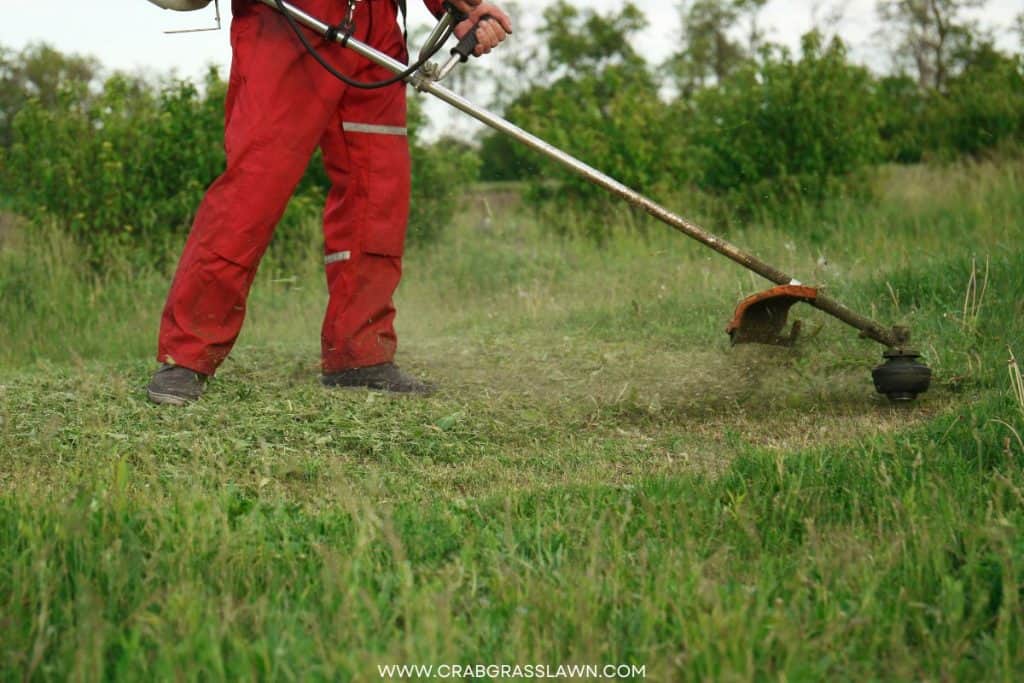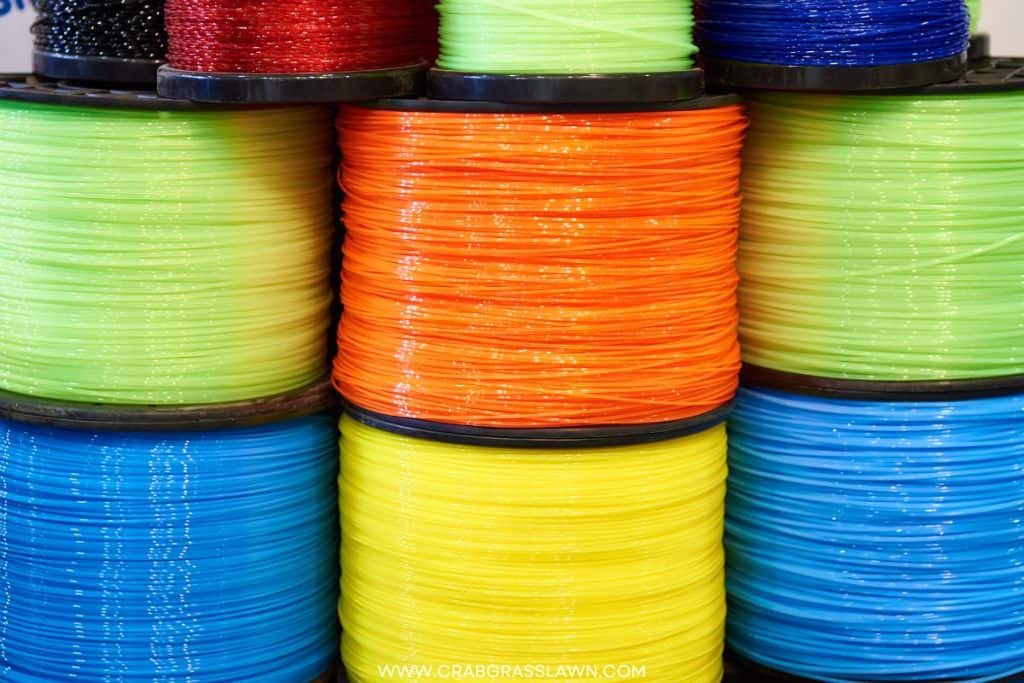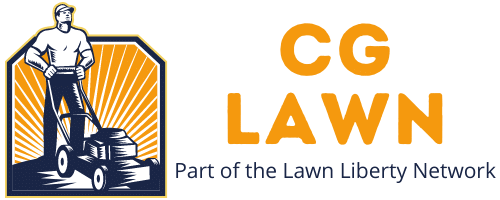A string trimmer is a handy piece of equipment to have in your lawn care tool arsenal for several reasons, starting with its ability to quickly trim and edge your lawn (an important lawn care task), cut weeds, clear brush, and various other landscaping chores.
If you’re wondering what string trimmer line size should you use:
- 0.085-inch to 0.105-inch – medium-duty trimming
- 0.110-inch to 0.130-inch – heavy-duty trimming
- 0.155-inch and above – professional or heavy-duty applications

Factors to Consider when Choosing a String Trimmer Line
There are several factors to consider when choosing a trimmer line, but I recommend referring to your owner’s manual.
Type of Vegetation Being Trimmed
The size of the weed eater line depends on the type of plants you are cutting whether weeds or grass. For example, you’ll need a tougher, thicker trimmer line to cut stubborn weeds and a thinner line to cut grass and other similar plants.
Size of the Lawn or Area being Trimmed
Generally speaking, the larger your lawn, the more powerful the string trimmer you’ll need. And as mentioned earlier, powerful string trimmers use thicker lines.
You can however use a battery-powered string trimmer from Amazon or your local home improvement center to cut weeds in sparkling yards, but it will take longer to get the job done.
Power of the String Trimmer
If you have a sprawling yard, you should buy a powerful string trimmer to tackle the whole job at once. And powerful string trimmers designed for heavy-duty use and aggressive cutting applications including tough grass cutting and weed cutting use larger diameter trimmer lines.

Are All Trimmer Line The Same?
Trimmer lines come in myriad different shapes and most styles and weights are interchangeable. However, larger/heavier lines may not fit all string trimmers.
String Trimmer Line Shapes
Standard Round line
Round is one of the common shapes in the trimmer line space, and doesn’t wear or break easily as other trimmer line shapes.
This makes a round-style trimmer line a great choice for cutting around cutting surfaces, trees, and fences. On the downside, a rounded line doesn’t possess a cutting edge, and rips grass instead of cutting it.
Square line
If you’re looking to tackle dense weeds, then a square trimmer line with its four sharp edges will do the trick. A square trimmer line boasts extra cutting power and can cut overgrown vegetation and undergrowth without any hiccups.
Twisted lines
Many expert gardeners claim that a twisted trimmer line offers a better-cut quality than a round trimmer line, making it a great choice for cutting back thick, heavy weeds.
The range of twisted trimmer lines reduces trimmer vibrations and noise levels and line wear and breakage when hitting hard surfaces.
Serrated Trimmer line
A serrated edge trimmer line works similarly to a serrated knife and leaves a clean cut while reducing your work time. Apart from time efficiency, a serrated line saws through heavy weeds and grass with a smile and is easy to use.
Pentagon line
Companies such as STIHL make pentagon-shaped trimmer lines, which provide twofold benefits – the hard edges of square lines and the abrasion durability of round lines.
Pentagon trimmer lines offer unmatched cutting performance for heavy weeds that grow in tough conditions.
Quiet line
The quiet line does just that and works quietly during use thanks to its integrated spiral grooves. Although quiet lines are primarily used with electric and battery-powered string trimmers, lawn care companies and lawn care pros often use them for larger yards.
String Trimmer Line Materials
String trimmer lines are mostly made from hardened, monofilament nylon. Some products feature aluminum, reinforced nylon, polymers, and other ingredients to reduce the chances of breakage.

What Are the Sizes of Trimmer Line?
Diameter
The diameter size of string trimmer lines varies, and the diameter ideal for you depends on the task. For example, a 0.065″-0.085″ diameter string trimmer line is ideal for light jobs such as trimming grass, and a 0.085″-0.110″ diameter line works best for thicker grass, heavier grass, and weeds. Any diameter size that’s thicker than 0.110″ is great for thicker underbrush.
Length
The length of a trimmer line could be anywhere between 10 and 25 feet. However, the optimal length that each string trimmer model can accommodate varies and is represented by a mark on the guard.
Weed eaters designed for heavy-duty work and commercial applications can house longer trimmer lines than models designed for small to medium-sized yards.
Weight
String trimmer lines are available in three weights namely light, medium, and heavy. 0.065- to 0.080-inch lines are considered lightweight, 0.080 to 0.110-inch lines medium weight, and 0.110-inch and above heavyweight.
Comparison of different line sizes
It’s highly important to choose the right trimmer line size for the job. If you use the wrong trimmer line to cut thick weeds, it will affect the cutting efficiency, the line will break and you’ll have to waste time reloading the spool.
| Trimming Purpose | Trimmer Line Diameter Range |
| Trimming young soft grass and weeds | 0.065 – 0.080 inches |
| Trimming thick-stemmed weeds | 0.080 – 0.110 inches |
| Trimming large yards with extensive needs and Commercial manual trimming | 0.110 inches (2.8 mm) and higher |
If you aren’t sure about what trimmer line to use, refer to the user manual that came along with your string trimmer.

What Size Trimmer Line To Use for Different Situations?
Light Duty Trimmer Line for Small Lawns or Gardens
A light-duty trimmer measuring between 1.2mm to 1.4mm is a great choice for light-duty work but may not be a good option if you have tough weeds and grass in a small lawn or garden.
If you have a small size lawn with tough weeds, you should step it up a notch and use a medium-duty trimmer line, one that ranges between 1.5mm to 2mm in thickness.
Medium Duty Trimmer Line for Larger Lawns or Heavy-Duty Trimming
Medium-duty trimmer lines measuring between 1.5mm to 2mm thickness are suitable for heavier grass and weeds even those that are located around wire fences.
Medium-duty trimmer lines generally come with fuel-powered string trimmers and are robust cords that come in a variety of shapes.
Medium gauge trimmer lines can be used to trim around hard surfaces like brick walls or concrete pathways and are a perfect choice for lawns sprawling several acres.
Heavy Duty Trimmer Line for Commercial Use or Tough Vegetation
A heavy-duty string trimmer line that measures between 2.4mm to 3mm is suitable for commercial use, dense weeds, woody plants, woody shrubs, or tough vegetation and to create crisp edges.
If you’re tackling thick grass, heavy weeds, nettles, etc, a thick trimmer line regardless of whether it’s a hexagon shape, twisted profile shape, or basic shape is a go-to option.
What Is the Cost of the Different String Trimmer Lines?
The cost of trimmer lines varies across manufacturers but is roughly around $8 for a basic trimmer line.
There’s no shortage of poor quality, cheap trimmer lines, but it’s recommended that you steer clear of them as they will probably not provide clean and in worse cases can damage your string trimmer.
How to Replace String Trimmer Line
Preparation
You don’t need any high-end tools to replace a string trimmer line because most models come with a fixed trimmer head.
However, you will have to detach the trimmer head in some models, and this can be easily done with a Phillips screwdriver.
A Step-By-Step Guide to Replacing Line
- Start by cutting the trimmer line to length. Cut 10 feet of the new trimmer line and take apart the cutting head if it’s detachable.
- To detach the cutting head, simply unscrew the bump knob and remove the inner wheel (spool housing) and spring.
- Get a good grip on the trimmer wheel and wrap the composite nylon line around it.
- Put the parts together and reinstall the trimmer head.
FAQs
Q. What Is the Strongest and Thickest Trimmer Line?
A. The strongest and thickest trimmer lines are ones that are 0.95 inches or greater in diameter/thickness.
Q. Is Thicker Trimmer Line Better?
A. A thick strimmer line is better for tough applications but isn’t needed if you’re dealing with light weeds and grass. However, it’s worth noting that a thick string trimmer line is much more durable than a thin strimmer line, leading to less breakage and wear-out.
Q. Is 25CC Trimmer Enough?
A. A 25cc string trimmer is generally more than adequate for normal residential yard work.
Q. What Shape of Trimmer Line Is Best?
A. A round trimmer line has a longer life and is also easier to replace than other trimmer line shapes.
Q. What Trimmer Line Do the Pros Use?
A. Most pros use a .095-diameter trimmer line
Q. How Powerful of a String Trimmer Do I Need?
A. The larger your lawn, the more powerful the string trimmer you should buy.
Final Thoughts
Choosing the right string line can be a bit overwhelming owing to the many options available. To make it easier, choose a lightweight trimmer line for smaller yards with soft weeds and grass and a larger trimmer line for stubborn grass and weeds. For larger lawns with either soft or touch weeds, choosing a larger diameter trimmer line is an excellent choice.
You May Also Like…
Best Walk Behind String Trimmers
Best Trimmer and Edger Combos
Pros and Cons of an Edger vs Trimmer
Hi, Alex Kuritz here. Growing up I remember that my family had one of the best lawns in the neighborhood. Richly green and lush. I did a lot as I grew up in terms of caring and tending for not only my family’s lawn but also my neighbors. I can say I have years of experience, and I am here to share it with you.


